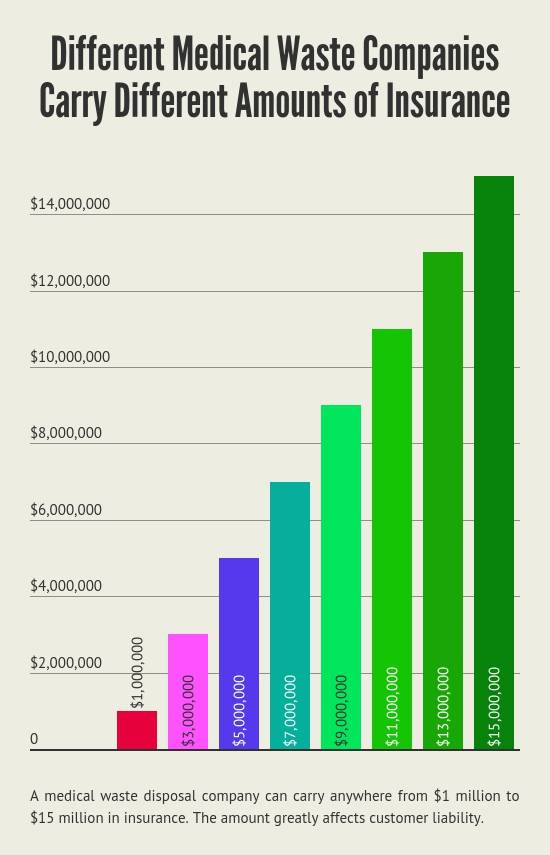Medical Waste: Who’s Liable for It?
It’s like ice water in the face when medical professionals learn of their cradle-to-grave responsibility for medical waste.
In other words, if I own a private practice, and it makes medical waste, I’m responsible for that waste forever. I can’t rest easy, even when the waste is picked up by a disposal company.
As the originator of that waste, it’s my liability until it’s rendered harmless.
For most doctors and healthcare administrators, that’s a terrifying prospect.
Too often, healthcare pros don’t learn of their responsibility until too late. They learn when they are fined, or even worse, convicted of a crime they could not possibly commit.
That’s why it’s crucial to make sure your medical waste disposal company carries enough liability insurance coverage to protect customers in the event of a catastrophe.
Medical Waste Companies, Insurance Coverage, and Practice Liability
RCRA fines for medical waste violations can amount to $70,000 per day, per violation. In that light, private practices are well-advised to find out how much medical waste liability insurance their disposal companies carry.
$70,000 isn’t so bad, but what if the violation goes for 30 days before it’s noticed by authorities? And what if there are multiple violations?
With several government bodies responsible for oversight, fines could range into the millions. Yet the liability defense provided by different medical waste disposal firms can vary wildly.
The chart below illustrates different potential levels of medical waste liability insurance coverage carried by a disposal company.
The amount of insurance held by a medical waste firm can be anywhere from $1 million to $15 million.
What is Cradle to Grave Medical Waste Liability?
The definition of cradle-to-grave liability is that medical waste originators are responsible for medical waste they create until it’s neutralized.
Neutralization can happen in several ways, including steam sterilization, microwaving, autoclaving, chemical treatment, or incineration.
Medical waste originators include hospitals, private medical practices and clinics, funeral homes, nursing homes, laboratories, veterinary clinics, and even hotels.
Processing equipment for medical waste is costly to own, maintain, and operate. That means most health care facilities outsource their waste disposal to a reliable company.
Medical Waste Compliance Never Guarantees Protection
It’s quite common for a medical waste disposal firm to soothe customer fears with assurances of compliance.
Waste companies frequently pepper their websites with logos from OSHA, the EPA, HIPAA, and the BBB. They use language like “100% Compliant and Certified” or “100% Guaranteed OSHA Compliance.”
The fact is, no matter how competent and compliant a medical waste firm may be, accidents can always happen. In a regulatory environment where medical waste liability stays with the originator, even the most competent of companies can’t protect their customers without a thick insurance shield.
Here’s How Much You Can Be Fined
Let’s get down to the nitty gritty. How much can a private practice be fined for a medical waste violation?
The types of medical waste violations below show how much money a private practice can lose over a violation.
Note that in each case, the medical waste violation happened after the waste left the health care facility. Yet the facility retained liability for the medical waste.
These are hypothetical violations based on real-world regulations. For some actual medical waste violation examples, skip to the next section.
$70,000 Fine for Missing Documentation
A medical waste company truck stops to refuel. While the driver is away, a snatch-and-grab thief ransacks the cab. The robber hastily shoves all visible items from the truck’s front seat into a bag. Before the driver can recover, his truck is inspected and the medical waste documentation is missing. The private practice that originated the waste gets a $70,000 fine from the EPA. The private practice still had liability for the medical waste, even though they did nothing wrong.
$60,000 Fine for a Missing Label
A defective label leaves the printing factory with inadequately applied glue. On a hot day, the label delaminates from a barrel of medical waste. The gently rocking motion of the truck in transit slides the label underneath a palette. At a routine traffic stop, the missing label earns a whopping $60,000 fine for the practice that created the waste. Even though this was an unforeseeable accident, the private practice is still liable for the violation.
$980,000 Fine for Open Containers
Vandals break into a medical waste treatment center. They open several barrels, then improperly reseal them. The error isn’t discovered until an OSHA inspection two weeks later. Since it’s deemed the barrels have been partially open for 14 days, the private practice that created the waste gets a fine of $70,000 per day. They retain responsibility for that waste until it’s rendered inert. Though it’s extremely unlikely that the EPA would mete out such a harsh fine for a no-fault violation, it’s still possible, as the real-world medical waste violations below illustrate.
Real World Examples of Medical Waste Violations
The medical waste violations above were hypothetical. They illustrate the cradle-to-grave liability of medical waste.
The examples below are taken from real-world events. We’ve struck out the names of the companies involved.
$537,900 Fine When Medical Waste Appears in Landfill
Could you lose half a million dollars because your medical waste showed up in a landfill? That’s what happened to a Pennsylvania hospital group. The group received a fine of $537,900 when residents near a landfill saw telltale red biohazard bags sitting atop mounds of regular trash.
It’s unclear whether actual employees of the hospital group, such as maintenance staff, delivered the waste directly to a landfill. Another scenario is that the hospital hired a medical waste disposal company in good faith to dispose of the waste properly. Either way, the hospital group created the waste, so they owned the liability for that waste, even after a medical waste company came and carted it away. That’s the essence of cradle-to-grave medical waste liability.
Veterinarian Hit with $20,000 Fine
A private veterinarian received a hefty fine when non-pathogen waste showed up in a landfill. The details of the case don’t relate whether the veterinarian had hired a medical waste disposal company to dispose of the waste.
The takeaway is that it’s not important whether the veterinarian put the waste in the landfill, or a private vendor did it. The key facts are;
1) The veterinarian originated the waste
2) The waste showed up in a landfill
Those two facts alone are enough to ensure the vet was liable for the crime. The liability belongs to the originator of the waste, no matter who disposes of it.
Medical Waste Liability Case Results in $70,000 Fine
In a similar case, a California hospital was hit with a $70,000 fine when its medical waste showed up in a public transfer station. Further, the waste was incorrectly packaged and labeled.
Once again, how the waste got into the landfill is not important. The hospital created the waste, and the waste was found at a transfer station. Because of cradle-to-grave liability of medical waste, the hospital was liable for it no matter how it got there.
Waste Generators Have to Know What Happens to Their Waste
The above examples and scenarios illustrate why facilities that make medical waste have to know what happens to it.
A private practice or clinic can’t keep tabs on every container of waste produced.
We can’t attach GPS tags to every bin or bag, send an auditing employee along for the ride, or include some kind of high-tech cellular monitor with each shipment.
Short of the extreme measures outlined above, health care facilities have another protective shield. They can ensure the medical waste disposal firm they partner with assumes all liability for the waste.
Since medical waste liability is a tricky business, this really comes down to insurance coverage.
Again, not all waste disposal firms are created equal when it comes to insurance. Coverage amounts can range from $1 million to $15 million. Know how much insurance your partner carries to protect you in the event of an unavoidable catastrophe.
What Happens to Medical Waste?
By this point, most health care readers understand they hold the liability for the medical waste they generate.
Yet many still don’t grasp the full scope of how many ways a medical waste violation or fine can rear its ugly head.
The medical waste disposal methods below show the numerous transportation and elimination methods. Note that the original source of the waste carries liability through all of them. As you scan them, be aware of the dozens of opportunities for chance to take a hand.
Methods of Transporting Medical Waste
Medical waste can be transported in trucks or through the mail. In either case, dozens of regulations govern the correct packaging, labeling, handling, and documentation of the waste. These include taping, containering, proper weight capacity, sealing, and color-coding. Waste must be packaged by type, with the proper manifests.
In one high-profile case, medical waste shipped through the mail leaked in a public mail sorting facility. When postal employees were ordered to clean up the spill, the post office itself was fined by the EPA. In this case, the facility that generated the waste was also liable.
Ways to Dispose of Medical Waste
Human blood products, microbiological waste, pathological waste, pharmaceuticals, sharps, animal waste, body parts, and used dressings are all kinds of medical waste.
Most medical waste is destroyed through incineration. Other methods of treating medical waste include autoclaving, microwaving, steam sterilization, chemical treatment, and biological treatment.
The many methods of medical waste disposal all present numerous opportunities for something to go wrong. Although a healthcare facility may not understand exactly how its waste gets treated, it’s still liable for that waste throughout the process.
Medical Waste Storage
OSHA, EPA, and RCRA regulations govern the storage of medical waste through complex regulations. Before waste gets picked up by a disposal company, and while it awaits treatment, the waste must be stored.
During storage, regulations require the waste stays safe from the public and is kept refrigerated. Throughout storage, liability for the waste remains with the facility that generated it.
How Much Insurance Does Your Medical Waste Disposal Vendor Have?
Now that you know how much medical waste liability matters, an important question pops up.
Namely, how can you know how much insurance a medical waste disposal company carries?
The simple answer? Ask.
While some medical waste disposal firms list the amount of their insurance coverage on their websites, most do not.
But a simple phone call can easily turn up the size of the company’s insurance umbrella. Once you know the size, you can more accurately determine the real-world value of the vendor’s waste disposal services. In the medical waste world, you don’t really know what you’re buying until you understand how well it protects you from unforeseen events.
Conclusion
After medical waste gets picked up, it can be transported by truck or by mail. It can be treated by incineration, steam sterilization, autoclave, microwave, or other methods. It often gets stored for a period of time while it awaits treatment.
The key takeaway? No matter what happens, liability for medical waste remains with the healthcare facility that originally created it. That means medical waste generators can incur heavy fines for infractions they didn’t commit.
Since responsibility for medical waste stays with the waste generator, it’s vital for private practices and clinics to know how much insurance their medical waste companies carry.
Some medical waste disposal firms can hold as little as $1 million in insurance, leaving their customers holding the liability bag. Meanwhile, some stack the deck in their customers’ favor with up to a $15 million insurance umbrella.




